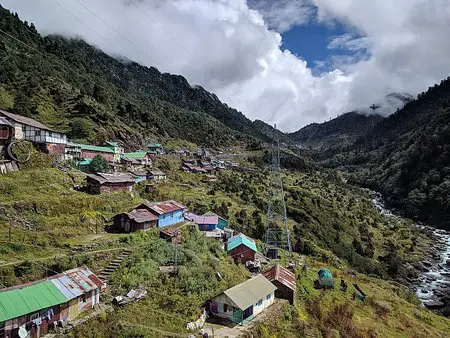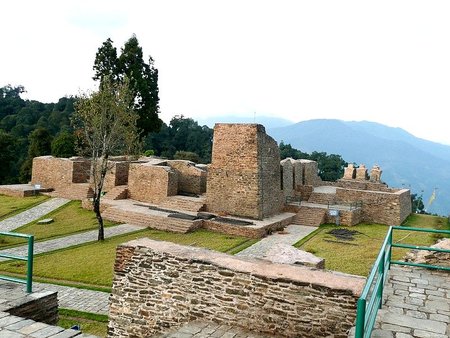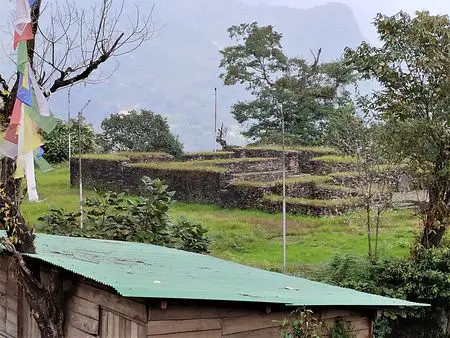Sikkim History
India's north eastern state Sikkim was once ruled by the independent Namgyal dynasty. In fact Sikkim has seen only one such Royal Kingdom in its entire history, and the monarchy was in power for over 300 years between 1642 to 1975. A king in the dynasty was known as 'Chogyal'.
The first Chogyal took over in 1642. Prior to that Sikkim was inhabited mostly by Lepcha tribe who were primarily farmers. The king established his capital in Yuksom in west Sikkim.
Yuksom Valley
Source: Shubhamshukla585, cc by sa 4.0
The second Chogyal (king) moved the capital to a nearby place called Rabdentse towards the end of 17th century. When he died in 1699, his son Chokdar Namgyal was crowned as the king when he was only 14 years old. But Sikkim always faced threats from some of its neighboring countries like Bhutan on its south-east and Nepal on its west, while Tibet on the north (another bordering country then and now part of China) remained a friendly neighbor for most part.
Rabdentse Palace Ruins
Photo: Anand Bhushan, cc by sa 3.0
Next year in 1700, Bhutan invaded and captured Sikkim and controlled the place until 1708. During this 8 year period, Chokdar Namgyal lived in Lhasa of Tibet. But how could he manage to find a shelter in Tibet? And why Tibet was sympathetic to the Namgyals of Sikkim? Because all the Chogyals of Namgyal dynasty through the next 333 years belonged to Buddhist community like the Tibetans, and their ancestral roots belonged to Tibet.
Other than performing royal administrative rule in Sikkim, one of the key missions of all these kings was to spread Buddhism in Sikkim which they succeeded to a large extent. In fact Sanyasis who coronated the first king in Sikkim were responsible for the most widespread Buddhism in Sikkim. The ministers and main office bearers of the Kingdom all through were Buddhists (i.e. Bhutias from Tibet). Basically Sikkim was under the control of Tibet both in administrative and religious fronts.
So the young Chokdar could easily find a home in Tibet when he had to leave Sikkim in 1700. But through his own merit and good work, he earned the blessings of the prevailing Dalai Lama administration in Tibet. Through their active mediation, Bhutan agreed to recede from Sikkim in 1708. So Chokdar returned to Rabdantse and took over charge of Sikkim again.
Although Sikkim and Tibet appeared to be seamlessly integrated, there was also a big difference between the two. The 17th century in Tibet was passing through the golden era of the 5th Dalai Lama. There were (and still are) several sects or clans in Buddhist communities. The followers of the ancient practice of Buddhism belong to the Nyingmapa sect and wear red hats. Kyargupa sect was established in 11th century. In 15th century Gelugpa Sect was established in Tibet who wore yellow hats.
Dalai Lama was head of this Gelugpa sect. Although there are several other sects or clans, Yellow Hat Sect (or Gelugpa Sect) emerged as the dominant sect. It is heard that the 5th Dalai Lama started acquiring the monasteries and shrines of the other sects by force and tried to convert monks of other sects into yellow hat sect. This forced many monks or lamas of other sects to move out of Tibet.
The Nyngmapa (red hat) lamas migrated to Sikkim in 1641 and started work on establishing a dynasty... the Namgyal dynasty that started in 1642. Meanwhile in the same year of 1642 the 5th Dalali Lama with Mongol military assistance threw out the existing king of Tibet and took over the complete charge himself as the ruler. And this resulted in establishment of lama administration in Tibet.
So as far as religious sect were concerned, there did exist a big difference between Sikkim and Tibet... Sikkim constituted of red hat Buddhists (Nyngmapa sect) while Tibet of yellow hats (Gelugpa sect). Even today you won't see much traces of yellow hats (i.e. Gelugpa sect) in Sikkim. Although this was a big difference between the common monks or lamas of the two places, the kings however got along well with each other taking cognizance of bigger matters of political, military and administrative significance.
70 years later, Sikkim had to again to go back to Tibet for their intervention due to threats from Nepal. During the dynasty of king Prithvi Narayan Shah in Nepal, the Gorkha community in Nepal started to become quite dominant and they started to expand their kingdom. In 1775, the son of Prithvi Narayan, i.e. king Singha Pratap threatened to attack Sikkim. Tibet sent a battalion of soldiers to support Sikkim and thwarted the move by Nepal's king.
But the Gorkha army generals of Nepal captured several parts of south Sikkim and started battles in various parts of Sikkim. This continued for several years... in 1790 a Gorkha general suddenly came and captured Rabdantse, the capital of Sikkim. King of Sikkim again had to flee and take shelter in Lhasa of Tibet where he eventually died. Then the Tibetans sent back the 5 year-old son of the King back to Sikkim along with some support. The son had to live in north and north-eastern part of Sikkim in extreme poverty because the fertile and prosperous lands of south Sikkim was occupied by Gorkhas as well as to some extent by Bhutan.
In 1791 Nepal attacked Tibet and captured a part of south Tibet including the Tashilhunpo Monastery and plundered that. But they could not hold it for long because China soon came in support of Tibet. The Ching dynasty of China was then in its peak. The combined military force of China and Tibet ousted the Nepalese military and progressed right up to Kathmandu. Nepal conceded and had to sign a treaty with Tibet. But Sikkim was not made part of that treaty. Why?
The Chinese army general was angered at the fact that although even Bhutan extended help in the operation with military forces, Sikkim did not. So the respective areas in Sikkim that were already captured by Nepal and Bhutan, were given to them formally through this treaty without seeking consent of Sikkim. This arrangement lasted for the next 25 years.
In 1814 the king of Sikkim started building his palace in a place called Tumlong, which is about 38kms from Gangtok, and the third capital of Sikkim was established here. It is located in North Sikkim within Mangan subdivision and near the Phodong Monastery.
Ruins of Tumlong Palace, North Sikkim
Next year a war broke out between the British East India Company and Nepal which the British won. Following this the Treaty of Sugauli was signed between the two in which Nepal had to return the whole of Sikkim (including the present Darjeeling district) to the British. The British also acquired the rights to recruit Gorkhas for their military service.
In 1817, the British and the king of Sikkim signed the Treaty of Titalia in a friendly gesture and the whole of Sikkim including Darjeeling was given back to the King. However the treaty mandated that the king would refer all foreign disputes arising out of Bhutan, Nepal and Tibet to the British for suitable arbitration. The king of Sikkim continued his capital in Tumlong and did not take it back to Rabdantse.
However subsequently the relationship between the British and the king of Sikkim started deteriorating. The British wanted Darjeeling back because they wanted to set up a health resort there. Although the king eventually agreed to lease out the land, the British cunningly capitalized on the lack of English knowledge of Sikkimese, they instead used the word 'Grant' in the deed. And in return, the British agreed to give a yearly allowance of Rs. 3,000 to the king which in those days was not a small amount. The allowance was subsequently increased to Rs. 6,000 per year.
Darjeeling quickly moved along the speedy track of progress and development under British governance. From a mere population of only around 100 in 1839 the population grew to 10,000 by 1849. But this created another problem for the king of Sikkim. The Lepchas (original inhabitants of Sikkim) started to move to Darjeeling to make a better livelihood out of the ongoing developments in Darjeeling resulting in king's work force getting diminished. This started another conflict between the king and the British. So the British resorted to importing work force from Nepal. The businesses and trade in Sikkim started shifting to flourishing market in Darjeeling which further angered the king.
The relationship went down so low that two British dignitaries Dr. Campbell and Sir Joseph Hooker who were travelling in Sikkim were arrested by the king in November 1849, kept under house arrest in Tumlong Palace, and the king started negotiating with the British on various matters for their release. But he had to eventually release them unconditionally on 24th December of the same year under tremendous pressures from the British.
The British by now had decided to take over Darjeeling for good and stopped the allowance to the king. In 1850 they captured and took over the entire terai area (lower plains) of Sikkim isolating Sikkim from rest of the plains. In 1861 Sir Ashley Eden with his army force of 2,600 went and captured Tumlong (then capital of Sikkim) and forced the king to sign a treaty in which Darjeeling was formally taken over by the British.
In 1864 Ashley Eden along with his forces went to Bhutan and made them to sign another treaty in Sinchula, by which the British took over the Dooars area (now part of Jalpaiguri district) and Kalimpong which were earlier captured by Bhutan. This Kalimpong area was once under the Sikkim dynasty but was captured by the Bhutanese. However having taken back Kalimpong from Bhutan, the British did not return it to the Sikkim king, instead they themselves continued to rule the area.
The furious & frustrated king of Sikkim having no other option reached out to Tibet for alliance. By this time the Chinese dominance in Tibet had significantly reduced because they lost two Opium Wars with United Kingdom (first between 1840 - 1842, and second between 1856 - 1860), and the Taiping Civil War further compounded the problems for Chinese. More over in 1876 the UK had ensured that Chinese accept the British doing business in Tibet.
So Tibet gladly accepted the proposal of friendly alliance from Sikkim. But the British East India Company was already planning a trade with Tibet. Having acquired Kalimpong, it became much easier for the British to construct a road all the way to the Jelepla Pass which connected Sikkim with Tibet. This road is today known as the famous and historic Old Silk Route.
Read: The
Historic Old Silk Route to know about this route which the British had constructed to initiate trade with Tibet. Among other materials silk was a main trading item.
Having noticed the road construction, the Tibetans thought that the British were perhaps planning an attack on them. So they built a fort on Tibetan side of Jelepla pass in 1886. The British on the other hand built a fort at Nathang valley (on Sikkim side) which is close to the pass and stationed soldiers there. But when it came to be known that the King of Sikkim (Thutob Namgyal) in the same year had signed a treaty with Tibet accepting that Sikkim and its people were subservient to and under control of Tibet, the battle between the British and Tibet actually became imminent.
In 1888 the British completely uprooted the Tibetans from Lingtu of Tibet and marched all the way up to Chumbi and returned. Next year the peace talks collapsed because of Tibet's stern stand. Eventually in 1890 through the
Anglo-Chinese Convention held at Kolkata it was accepted by the Chinese that Sikkim would be under the control of the British and water sources of
River Teesta would be part of Sikkim. However Tibet (still under Dalai Lama's administration) did not accept this until 1904.
According to the Anglo-Chinese Convention the British appointed John Claude White as the political officer in Sikkim. White chose Gangtok as his work location, set up his office there and asked the King of Sikkim to return from Tibet to Sikkim. Having returned the king immediately realized that he was powerless and the entire administration was under the control of White. The king decided to flee back to Tibet through Nepal along with his wife. But Nepal intercepted them and handed them over to the British again. Both were kept under house arrest, first in Darjeeling and later in Kurseong.
The Sikkim king and the queen realized that it would be impossible for them to get out of the clutches of the British unless they start cooperating with them. John Claude White moved the capital of Sikkim from Tumlong to Gangtok in 1898 and the Sikkim king accepted that.
Next year the king and the queen were released. The wonderful road on a flat land -
The Ridge came up. At one end of the Ridge the
Tsuklakhang Palace and Monastery was built where the royal family lived and offered prayers. The king Thutob Namgyal and John White finally became friends.
However Tibet's non-acceptance of Anglo-Chinese Convention of 1890 still meant that there was no universal acceptance to the northern border of Sikkim. In 1903 Colonel Younghusband with his British troop won over Lhasa in Tibet. Next year during an agreement which took place in the Potala Palace of Dalai Lama, Tibet finally accepted the Anglo-Chinese Convention of 1890 and also agreed that the British would have right to do business in Tibet. The northern border of Sikkim too was now finalized.
Sikkim becoming a state of India
Sikkim continued to be an independent monarchy... in fact at the time of Titallia Treaty between the British and Sikkim, the British had guaranteed independence or sovereignty to the King of Sikkim. However following India's independence in 1947, the British passed on the guarantee to India.
Then a popular vote took place to consider if Sikkim would be part of India, but that failed. So the first Prime Minister of India Jawaharlal Nehru decided to keep Sikkim under protectorate status... meaning that Sikkim would continue to function independently under the monarchy but its defence, external communication & diplomacy would be controlled by India.
This arrangement continued for quite sometime followed by a series of events. In 1964, Indian Prime Minister Jawaharlal Nehru passed away and in the following year (1965) the last Chogyal (King) Palden Thondup Namgyal was coronated as the king and took over the kingdom of Sikkim.
In 1966 Nehru's daughter Indira Gandhi became the Prime Minister of India. And in August 1968 a massive protest broke out in Sikkim to make it free from India and establish it as an independent country. Indian army was immediately called in to thwart the move which they successfully did... but thousands of Sikkimese people were killed, wounded and arrested in that operation. In 1973 India imposed an army rule in Sikkim.
Indian Government all along considered the King of Sikkim (Palden Thondup Namgyal) as a political threat and causing internal rebellion to retain Sikkim under his independent monarchy. This became apparent when his wife Hope Cooke (of American origin) published an article stating unauthorized possession of several Sikkmese properties by India. In April 1975, the Indian army arrested the King of Sikkim and imprisoned him.
A few days later, the parliament of Sikkim (which was under the control of India) announced that the King of Sikkim has been deposed. On 16th May 1975, the Parliament of India declared that Sikkim officially became part of India and its 22nd state.
Related Articles
|
Visitors' Reviews/Comments
|


